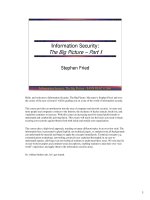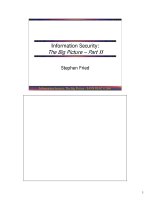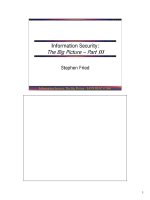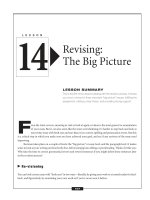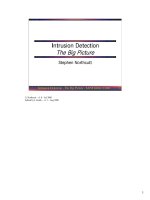The big tech score
Bạn đang xem bản rút gọn của tài liệu. Xem và tải ngay bản đầy đủ của tài liệu tại đây (958.09 KB, 256 trang )
BusinessCulinaryArchitecture
ComputerGeneral Interest
ChildrenLife SciencesBiography
AccountingFinanceMathematics
HistorySelf-ImprovementHealth
EngineeringGraphic Design
A p p l i e d S c i e n c e s Psychology
Interior DesignBiologyChemistry
WILEYe
BOOK
WILEY
JOSSEY-BASS
PFEIFFER
J.K.LASSER
CAPSTONE
WILEY-LISS
WILEY-VCH
WILEY-INTERSCIENCE
7525_Kwatinetz_00fm_ad_qxd 11/3/00 1:27 PM Page i
The Big
Tech Score
7525_Kwatinetz_00fm_ad_qxd 11/3/00 1:27 PM Page ii
7525_Kwatinetz_00fm_ad_qxd 11/3/00 1:27 PM Page iii
THE
BIG
TECH
SCORE
A Top Wall Street Analyst
Reveals Ten Secrets to
Investing Success
MIKE KWATINETZ
DANIELLE KWATINETZ WOOD
John Wiley & Sons, Inc.
New York • Chichester • Weinheim • Brisbane • Singapore • Toronto
7525_Kwatinetz_00fm_ad_qxd 11/3/00 1:27 PM Page iv
∞
This book is printed on acid-free paper. ࠗ
Copyright © 2001 by Michael Kwatinetz and Danielle Kwatinetz Wood.
All rights reserved.
Published by John Wiley & Sons, Inc.
Published simultaneously in Canada.
No part of this publication may be reproduced, stored in a retrieval system or transmitted in any form or by any means, electronic, mechanical,
photocopying, recording, scanning or otherwise, except as permitted
under Sections, 107 or 108 of the 1976 United States Copyright Act, without either the prior written permission of the Publisher, or authorization
through payment of the appropriate per-copy fee to the Copyright Clearance Center, 222 Rosewood Drive, Danvers, MA 01923, (978) 750-8400,
fax (978) 750-4744. Requests to the Publisher for permission should be
addressed to the Permissions Department, John Wiley & Sons, Inc., 605
Third Avenue, New York, NY 10158-0012, (212) 850-6011, fax (212) 8506008, E-Mail: PERMREQ @ WILEY.COM.
This publication is designed to provide accurate and authoritative information in regard to the subject matter covered. It is sold with the understanding that the publisher is not engaged in rendering professional
services. If professional advice or other expert assistance is required, the
services of a competent professional person should be sought.
ISBN 0-471-39592-7
Printed in the United States of America.
10 9 8 7 6 5 4 3 2 1
7525_Kwatinetz_00fm_ad_qxd 11/3/00 1:27 PM Page v
Contents
Foreword by Scott W. Schoelzel . . . . . . . . ix
Preface . . . . . . . . . . . . . . . . . . . . . . . xiii
Acknowledgments . . . . . . . . . . . . . . . . xvii
Chapter 1 . . . . . . . . . . . . . . . . . . . . . . . 1
The Big Tech Score Theory of Investing
●
●
●
●
●
A Few Key Points
Why You Can Beat the Pros
Why This Book?
Playing the Stock Market
Summing Up
Chapter 2 . . . . . . . . . . . . . . . . . . . . . . 13
Concentrate Your Investments on a Handful
of Companies
●
●
●
●
Creating Investment Pools
Scared Money Rarely Wins
Timing Is Everything
Summing Up
v
7525_Kwatinetz_00fm_ad_qxd 11/3/00 1:27 PM Page vi
vi
contents
Chapter 3 . . . . . . . . . . . . . . . . . . . . . . 23
Buy Low, Sell High
●
●
●
●
●
Feeding the Frenzy
Getting Specific
In and Out?
The Long-Term Portfolio
Summing Up
Chapter 4 . . . . . . . . . . . . . . . . . . . . . . 35
Don’t Invest Blindly
●
●
●
The Seven Deadly Sins
Summing Up
Interview with Thomas G. Kamp, Alliance Capital
Chapter 5 . . . . . . . . . . . . . . . . . . . . . . 45
Invest in Great Management
●
●
●
●
●
●
●
What to Look For
Hail the Founder
Help Wanted
Observing a Company in Hot Water
Hiring the Best People, Period
Summing Up
Interview with Mark Kingdon, Kingdon Capital
Management
Chapter 6 . . . . . . . . . . . . . . . . . . . . . . 67
Look for Companies with a Competitive
Advantage
●
●
●
●
●
The Virtual Enterprise
The Economic Advantage
A Product That Can’t Be Replicated
The Unbeatable Brand
Almost, but Not Quite
7525_Kwatinetz_00fm_ad_qxd 11/3/00 1:27 PM Page vii
contents
●
●
vii
Summing Up
Interview with Larry Solomon, Capital Group
Chapter 7 . . . . . . . . . . . . . . . . . . . . . . 87
Love Companies Customers Love
●
●
●
●
●
●
Providing Better Service
Creating an Elite Product
Delivering More Value
Putting It Together
Summing Up
Interview with Fred Kobrick, Kobrick Capital Fund
Chapter 8 . . . . . . . . . . . . . . . . . . . . . . 105
Look for Long-Term Thinkers
●
●
●
●
●
Prime Examples of Short-Term Thinking
Going Long
Prime Examples of Long-Term Thinking
Summing Up
Interview with Roger McNamee, Integral Capital Partners
Chapter 9 . . . . . . . . . . . . . . . . . . . . . . 117
Always Look Forward, Not Backward
●
●
●
●
Betting on the Old-Timers
Betting on the New Wunderkind
The Do-It-Yourself Mentality
Summing Up
Chapter 10 . . . . . . . . . . . . . . . . . . . . . 137
Pick Only High-Growth Companies
●
●
●
●
What Spurs Growth?
The Stockholder Screen Test
Growth Is Hard to Maintain
Summing Up
7525_Kwatinetz_00fm_ad_qxd 11/3/00 1:27 PM Page viii
viii
contents
Chapter 11 . . . . . . . . . . . . . . . . . . . . . 151
The Best Stocks Are Cheaper Than You Think
●
●
●
●
The Game
Applying Guidance Bias to Valuation
A Word of Warning
Summing Up
Chapter 12 . . . . . . . . . . . . . . . . . . . . . 171
Mike and Danielle’s Portfolios
●
●
●
Mike’s Portfolio
The Unknown Portion of the Portfolio
Summing Up
Chapter 13 . . . . . . . . . . . . . . . . . . . . . 183
The New Technology Era
●
●
●
●
A High-Tech Primer
Linux
Solid, if Not Sexy
Summing Up
Chapter 14 . . . . . . . . . . . . . . . . . . . . . 203
The Fourth Wave of the Web
●
●
●
●
●
History Lesson
The Fourth Wave and You
The Future of the Fourth Wave
Place Your Bets
Summing Up
Epilogue. . . . . . . . . . . . . . . . . . . . . . . 221
Index . . . . . . . . . . . . . . . . . . . . . . . . . 223
7525_Kwatinetz_00fm_ad_qxd 11/3/00 1:27 PM Page ix
Foreword
T
here are people that each of us meet over the course of
our lives who are truly extraordinary at what they do. Such
a person might be a doctor, an architect, or a teacher you had in
high school. They come from all walks of life. While you’re not
always exactly sure what it is that makes them extraordinary, you
recognize it when you see it. You don’t need to spend even five
minutes with John Chambers, of Cisco, to realize: Hey, this guy
isn’t just good, he’s spectacular. I put Mike Kwatinetz in that upper
echelon of extraordinary people.
I met Mike in 1991. I don’t actually remember what stock we
first talked about. Mike was an analyst at Sanford Bernstein and I
was immediately impressed with the depth of his knowledge.
Before becoming an analyst, Mike was a mathematician and a software engineer. It was apparent from our first meeting that he had
a true first-hand sense of the software industry and the complexities inherent in technology investing.
We have talked about dozens of companies over the years, as
well as the whole technology landscape—Microsoft, Dell, Cisco, the
recent rise in the popularity of Linux, Sun Microsystems, the fragmentation of Unix, IBM, Apple, and many more. With respect to
Microsoft and Dell, two positions in which we both made a lot of
money for our clients and shareholders, we debated everything—
from various new products to their respective Internet strategies,
ix
7525_Kwatinetz_00fm_ad_qxd 11/3/00 1:27 PM Page x
x
foreword
the direct-sales model to the various lawsuits (there were actually
three), and the proliferation of NT to what the future holds for each
company. Mike had an uncanny ability to identify the key variables
early on and the conviction to stay focused on the fundamentals.
I am not the only person who feels this way. From time to time,
I’ve talked with managers from around the country. It’s very clear
that my contemporaries feel the same way as I do about Mike.
That’s true at the companies as well. I once asked Mike Brown, the
CFO at Microsoft, who he thought was doing the best work on the
stock, and he told me Mike Kwatinetz.
In addition to being a superb quantitative analyst, Mike has
always been able to add the qualitative side. Good investments rest
not only in being able to read a financial statement but in being
able to read people and organizations. When you’re investing, the
people are paramount. When you invest in a Microsoft or a Dell,
you’re investing your money with Bill Gates or with Michael Dell,
and with their respective management teams. There are so many
intangibles in running each of these businesses that you have to
make something of a leap of faith. You have to believe that the guys
running the business will, when push comes to shove, make the
right decisions. You have to feel confident that they are the type of
people you feel comfortable investing your money with for the long
run. Finding market-leading companies, with a properly leveraged
business model, run by extraordinary people is a tough combination to beat.
I remember that a number of years ago, there was a really hot
networking company I kept getting calls about. Everyone was
telling me, “If you own Cisco, you have to own this.” I went out to
see this company. I knew within the first 20 minutes that not only
was I never going to own this stock, it was probably one of the great
shorts of all time—which subsequently proved to be correct.
The stock market today is more volatile than ever, and it’s easy
to get preoccupied with short-term performance and lose sight of
your true objectives. The Big Tech Score provides readers with a rare
opportunity—the opportunity to gain insight into an investment
process that works, from one of Wall Street’s true superstars.
The Big Tech Score is an easily read, common-sense approach to
technology investing. Mike and I have very consistent views as to
7525_Kwatinetz_00fm_ad_qxd 11/3/00 1:27 PM Page xi
foreword
xi
how individuals should assess, monitor, and maintain their own
investments. They’re all laid out in this book—buy what you know,
honestly analyze your own risk profile, look for an extraordinary
management team, analyze a company’s true competitive advantage, look for companies that customers love, monitor their
progress, and stay the course.
Staying the course is critical. I believe more people make
more money on their homes than they do trading or playing the
stock market. Why? Because people own their homes for an average of seven years, but they own their stocks for about seven
weeks. The big returns don’t happen in the third week or the
third month; the third or fourth year is when you really begin to
reap the benefits of a well-placed investment. I read recently that
the average turnover for stocks on the Nasdaq is something like
39 days. I think that if people would commit to a more realistic
time horizon when they invest in companies, they’d be much better off.
The Big Tech Score is one of those five or six must reads that
should be in everyone’s personal investment library. It provides a
framework for how to think about investing. It rescues investors
from having to be so preoccupied with the day-to-day-ness of the
marketplace and teaches them how to think analytically about
companies and their true long-term prospects.
Scott W. Schoelzel
Portfolio Manager, Janus Twenty Fund
7525_Kwatinetz_00fm_ad_qxd 11/3/00 1:27 PM Page xii
7525_Kwatinetz_00fm_ad_qxd 11/3/00 1:27 PM Page xiii
Preface
I
n the winter of 1990, fresh from the sale of the computer consulting firm I’d run for 10 years and itching for a new challenge, I set out to conquer Wall Street. I came armed with a PhD in
mathematical modeling, an MBA in accounting, and whatever
knowledge I’d gleaned from 15 years of designing software and
computer application systems.
I had lots of gumption but absolutely no Wall Street experience. Sanford Bernstein, a respected investment boutique specializing in detailed industry research and evaluation, was
looking for a stock research analyst to specialize in the computer
industry. I somehow charmed my way into an interview and was
hired.
After nine months of work on my first report, I launched as an
analyst on January 2, 1991, with a 234-page market research forecast on the PC software industry. I was under the microscope from
the start. My analysis of Microsoft especially generated a lot of
heat. Word on the Street was that Microsoft’s 1992 fiscal earnings
would be about $3.70 per share (this was the average or consensus
estimate amongst sell-side analysts, a number like those often
printed in the Wall Street Journal, New York Times, and other publications). My report placed them at $4.76, a significant difference
considering that most estimates varied by no more than $0.10 or
$0.20 from the consensus.
xiii
7525_Kwatinetz_00fm_ad_qxd 11/3/00 1:27 PM Page xiv
xiv
preface
Because I worked for Sanford Bernstein, my analysis couldn’t be
completely dismissed. But my findings were met with considerable
skepticism. How could a new analyst be right when he disagreed so
dramatically with all his more senior colleagues? How could a billiondollar company like Microsoft continue to grow at such a fast rate?
Most analysts thought it inevitable that Microsoft stock would begin
to slow down. My prediction meant an increase in earnings per share
of more than 40 percent over the next year. The pressure was on.
Soon, even I started to doubt my analysis. Sure, I’d been careful, but maybe I’d missed something. Things hit rock bottom when
I learned that an important client had asked one of the Bernstein
salespeople, “What was Mike smoking when he came up with these
numbers?”
I decided to face things head-on. I asked the salesperson to set
up a meeting with that client, a brilliant investor named Glenn
Doshay who was then at Ardsley Partners and now runs his own
firm, Palantir Capital.
Glenn agreed to meet me because, if I was right, Microsoft stock
was worth quite a bit more than the price at which it was trading; his
company could reap huge profits. The salesman warned that Glenn
would grill me mercilessly. I clung to the hope that I held a considerable ace in the hole: I actually thought the right Microsoft estimate
was $5.40. Worried that something might go wrong, I’d made my
model more conservative. Barring an unforeseen disaster, if my
work was correct, Microsoft would exceed my estimate considerably.
As a new analyst, I also had somewhat of an edge. I’d had the
luxury of spending nine months working exclusively on my
research. Once analysts officially launch, they spend a good chunk
of their time meeting with institutional accounts, pitching potential investment banking clients, and “firefighting”—responding to
the various issues and miniemergencies that arise each day. Only a
fraction of their day is available for research. When an analyst is
producing his or her initial work, however, none of these distractions exist.
As the new kid on the block, I had triple the number of hours
that my competitors had to spend picking apart Microsoft. On the
other hand, as veterans they had had years of experience reading
the nuances of company signals, learning what might go wrong,
7525_Kwatinetz_00fm_ad_qxd 11/3/00 1:27 PM Page xv
preface
xv
seeing how model projections could be missed, and so on. As my
meeting with Glenn approached, I double-checked my work, fearing that I might have overlooked an obvious risk that would make
me look ridiculous and sabotage my fledgling career.
Glenn’s firm, Ardsley, was a hedge fund which traded large
amounts of stock continuously and often shorted stocks (selling
shares that it didn’t own—betting that the price would go down
and that it could then cover or buy the shares back at this lower
value) in order to hedge its bets. Because they trade so frequently,
hedge funds tend to aggressively seek every bit of incremental
information. Funds that hold stocks for longer periods often act
more conservatively and may not be as concerned with acting on a
hot but unproven analyst tip.
Before the meeting, I tried to think of every tough question
that could possibly be asked. The meeting began and I sat in front
of Glenn’s desk while he remained behind it. All through our conversation, Glenn continued to check the Reuters quotes and news
releases being spit out of his PC, and frequently picked up the
phone to give buy or sell orders. For my part, I led him step by step
through the assumptions and analyses incorporated into my models. Each time I’d start to think he wasn’t paying attention to me,
he’d let loose with a series of sharp questions that showed he
hadn’t missed a thing. After about an hour, Glenn turned to the
salesperson and said, “He could be right.”
His vote of semiconfidence qualified me for my next inquisitor:
Roger McNamee, who at the time was running the Science & Technology Fund for T. Rowe Price. (Roger and John Powell have since
started their own firm, Integral Capital Partners, which invests in
technology stocks and engages in mezzanine financing, putting
money into private companies that are getting close to the initial
public offering stage. Roger is perhaps the most widely quoted person on Wall Street, even though his “Wall Street” firm is located
3,000 miles away, in the heart of California’s Silicon Valley.)
When a new analyst meets with a Roger McNamee or a Glenn
Doshay (or any number of other savvy investors), they have to earn
their spurs. Having succeeded with Glenn, I felt pretty good. After
meeting with Roger, I was wrung out. It became obvious that no
matter how much I’d prepared, there were things I didn’t know.
7525_Kwatinetz_00fm_ad_qxd 11/3/00 1:27 PM Page xvi
xvi
preface
Investors in Roger’s funds are a virtual Who’s Who of technology executives. As a result, he has a timely and formidable base of
broad and detailed knowledge. He caught me with my pants down
at least once, with questions I hadn’t even considered. I did my
best to keep up. At the end of the hour-and-a-half meeting, to my
relief, Roger told his salesperson that I knew what I was talking
about.
Getting the endorsement of Glenn Doshay and Roger
McNamee was like a rite of passage. I was off and running in the
PC software category—and when Microsoft results for fiscal 1992
met my secret estimate of $5.40, I was officially anointed and on
my way.
A WORD ON OUR ADVICE
The technology sector is an extremely fast-paced business. The
stock prices for the companies I describe in this book were constantly changing during the course of its writing and production.
Because of that, on one page, I may say, for example, that Microsoft
is trading at $110 per share, while on another page I place the stock
as trading at $80. Huge developments take place in technology on
a daily basis, and such changes are nearly inevitable. Between the
dates of finishing the manuscript and going to press, major events
occurred (for example, PaineWebber, as I predicted, was acquired,
and Microsoft lost its first round with the Department of Justice).
It’s next to impossible to provide up-to-the-minute numbers in a
printed format, but the advice contained within these pages should
stand you in good stead, regardless of what the market is doing at
any given time.
7525_Kwatinetz_00fm_ad_qxd 11/3/00 1:27 PM Page xvii
Acknowledgments
A
lot went on behind the scenes to make this book a reality.
First of all, Danielle and I would like to thank Joy Tutela
and everyone else at the David Black literary agency, for believing
in this book in its infancy and delivering it into the right hands. We
just hope that Joy hasn’t learned so much about investing that she
decides to leave her day job (and us agentless). Thanks also to
Debra Englander, our editor, for her excitement about our ideas,
and much help in fleshing them out.
I’ve been lucky enough to work with some of the smartest people in the business and even luckier that many of them agreed to
be quoted in this book. First and foremost, thanks to Scott
Schoelzel—you continuously amaze me with your insight into the
people and stories behind the stocks. I’ve also kept counsel with
some of the best and brightest Wall Street has to offer. Six (in addition to Scott) contributed greatly to this book: Tom Kamp, Mark
Kingdon, Fred Kobrick, Roger McNamee, Quint Slattery (one of
my partners), and Larry Solomon.
I would never have gotten to the place I am today without the
good fortune to have worked with the people behind some of the
most incredible tech companies ever. Hopefully, after reading this,
they’ll all still be talking to me. Thanks especially to the past and
present executives at Allaire, Apple, BSQUARE, Compaq, Dell,
xvii
7525_Kwatinetz_00fm_ad_qxd 11/3/00 1:27 PM Page xviii
xviii
acknowledgments
Gateway, Handspring, Hewlett-Packard, IBM, Liberate, Microsoft,
Network Associates, Onyx, VA Linux, and Wind River.
Thanks to Christine Ivanov, who holds my life together and
who’s created every great graphic I’ve ever used. Thanks to Hans
Roderich, who’s been my partner in crime for much of the
research contained in this book. And thanks to my other partners
at Azure—Paul Ferris, Cameron Lester, and Paul Weinstein—I’m
looking forward to incredible things.
Thanks to Mike Greenstein, who, despite his skepticism, introduced us to our agent. Thanks to Lee Spelman and Joel Pitt for
reading the book and helping correct just a few of our mistakes.
And thanks especially to Don Katz, for fantastic advice and invaluable support.
Most of all, thank you to Eric—not only for his insights, but for
agreeing to many months of no social life. And thanks to Michelle,
my wife and partner, for contributing to making this book happen
in more ways than can be mentioned.
7525_Kwatinetz_00fm_ad_qxd 11/3/00 1:27 PM Page xix
The Big
Tech Score
7525_Kwatinetz_00fm_ad_qxd 11/3/00 1:27 PM Page xx
7525_Kwatinetz_01_ad_qxd 11/3/00 1:27 PM Page 1
Chapter one
◆
THE BIG TECH SCORE
THEORY OF INVESTING
A
s a Wall Street analyst, I’ve had the good fortune to be one
of a few select people granted consistent access to the
strategic thinking at a number of high-flying technology companies.
Every week, I spend close to 70 hours living, breathing, studying,
and talking about these companies with the smartest investors in the
world. Over time, I’ve come to believe that there are certain attributes that the best companies share. It doesn’t hurt to have spent
every day for nearly 10 years observing two of the most successful
companies of our era, Microsoft and Dell Computer Corporation.
Many people can’t resist the thought of big money, and there’s
no denying that playing the stock market can sometimes lead to
juicy rewards. But stocks are serious business and dabblers often
get burned. Winning in the stock market requires discipline, hard
work, and focus.
Identifying great companies is only the first step. An even
greater challenge is deciding whether to stick with them when
you’re already ahead 200, 300, or even 500 percent. Take Dell, for
example. Someone who invested $10,000 in Dell in 1994 and
cashed out when they had a five-bagger (five times the investment,
or $50,000) would have missed the opportunity to watch that initial $10,000 shoot up to $1 million in less than five years.
1
7525_Kwatinetz_01_ad_qxd 11/3/00 1:27 PM Page 2
2
the big tech score
The amateurs aren’t the only ones who missed that boat.
Believe it or not, many analysts and portfolio managers found it
just as difficult to stay with Dell over the long haul. I’ve had the
good sense to stick fast to Dell and Microsoft as they became 10baggers, 20-baggers, and, in Dell’s case, over a 100-bagger. These
stocks hit some low points, believe me. But if you know what to
look for in a company, even as the media trumpets its downfall and
everyone else is scrambling to sell, then it shouldn’t matter what
conventional wisdom says about it—you’ve got the tools required
to judge for yourself. This book will provide you with those tools so
that you will never be dependent on “expert” advice again. You’ll
be the expert.
THE GAME PLAN
1. Read the book.
2. Do the homework.
3. Pick 4 to 7 stocks for your portfolio.
4. Commit to 10 hours a month following them.
A FEW KEY POINTS
Sound investing can make you more money than you could ever
hope to save from your job. And a few percentage points difference in annual return can mean big bucks over time. A 30-year-old
woman who invests $10,000 and earns a 6 percent return (about
average for low-risk bonds) until she is 65 will have a yield of
$77,000. A 12 percent compound annual return (the average
return for stocks over the past 50 years) on the same initial investment will give that same woman a nest egg worth $528,000 come
retirement.
Pretty good, but still not up to our standards. I want your stock
investments to yield a 25 percent return, and this book is going to
help you achieve those results. It takes a little bit more work, but I
think it’s worth it. How worth it? Had that same woman invested the
7525_Kwatinetz_01_ad_qxd 11/3/00 1:27 PM Page 3
the big tech score theory of investing
ⅷ
Figure 1.1
3
Retirement Nest Egg Results.
AGE
INVESTMENT
RETURN
30
$10,000
6%
30
10,000
12
528,000
30
10,000
25
24,000,000
RESULT AT 65
$
77,000
initial $10,000 the big tech score way, her money would have ballooned
to more than $24 million come retirement time (see Figure 1.1).
No Pain, No Gain?
Winning in the stock market is kind of like losing weight. A consistent, steady approach can yield great results, but everyone will
try to convince you that it’s all or nothing—“No pain, no gain” and
all that. Just as an inactive 500-pound person should not begin a
diet regime by trying to run a 26-mile race, an amateur investor
shouldn’t begin his or her stock experience by throwing money
into 20 or 30 stocks.
To win on Wall Street you don’t need to start with a huge
bankroll. You don’t need to listen 24-7 to Moneyline or memorize
the Wall Street Journal. You don’t need to be up on every industry
coming down the pipe or informed about every merger and acquisition taking place. What you need to do is focus. Take the phrase
“jack-of-all-trades, master of none” to heart. It’s better to know a
lot about a little than a little about a lot. Choose a handful of
stocks, dedicate at least 10 hours a month to following them, and
make yourself an expert.
The Seven Secret
How many is too many? I’m a professional analyst. I spend nearly
70 hours each week analyzing stocks. I have people working for me
to help weed through the plethora of information. I have access to
top management and resources that will be a challenge for you to
7525_Kwatinetz_01_ad_qxd 11/3/00 1:27 PM Page 4
4
the big tech score
acquire. Still, even with all of these advantages, I feel that the maximum number of stocks I can thoroughly follow is 15. And that’s
the maximum—I try to keep it between 10 and 12.
Presumably you have a job and a string of other commitments.
You’re functioning at less than half my capacity. The number of
stocks you own should be a reflection of the amount of time you
can dedicate to following them. When you’re creating your stock
portfolio you should be thinking in the 4- to 7-stock range. That’s
the maximum number of companies that you have a chance of following well.
If you have less than 10 hours a month to devote to research,
buy fewer stocks. This will increase your risk. But I’d prefer that you
own two stocks and know them inside out to your owning seven and
not really understanding any of them.
WHY YOU CAN BEAT THE PROS
I’m a big fan of diversity. I’ve been able to be pretty aggressive with
my stock portfolio because it’s only a small portion of my savings.
The rest of my money is in “safer” things, such as mutual funds or
bonds (covered in more detail in Chapter 2). That said, the stock
portion of my investment pool has left the other portions in the
dust. Part of this is due to unheard of stock performance during
the 1990s, but a lot of it has to do with focus. My mutual fund manager and I may be playing the same market, but we’re playing an
entirely different game. So are you.
David and Goliath
When it comes to investing, the professionals have the home-field
advantage. Mutual fund managers get information faster than you
do; they spend all of their time submerged in the stock market;
they have professional analysts advising them; and they pay virtually no commission when they trade stocks.
Given all of these advantages, how can you hope to outperform the professionals? Your amateur status entitles you to benefits the pros can’t enjoy. Let me explain.

